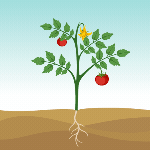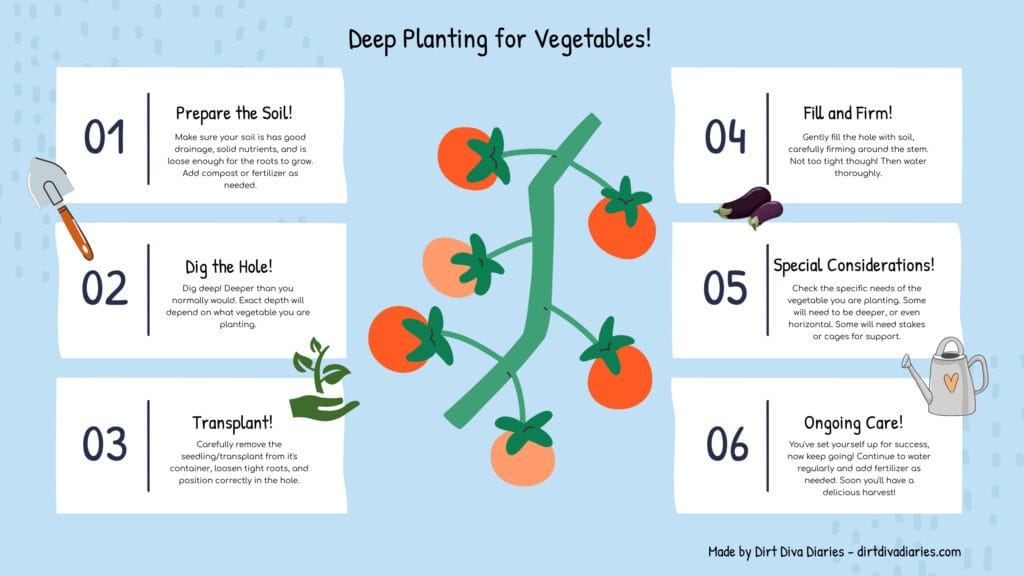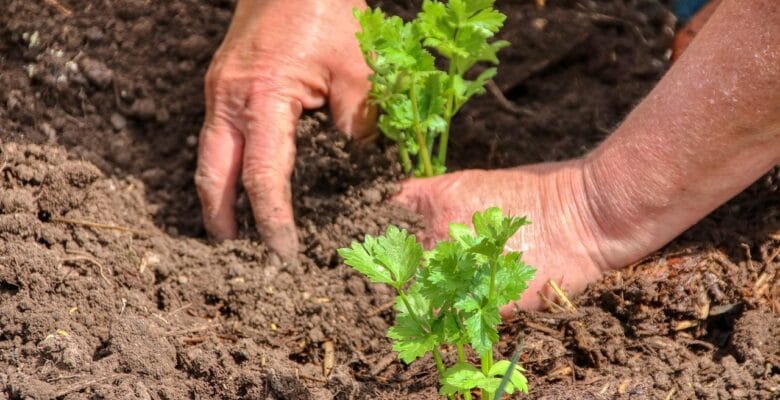Disclosure: This post may contain affiliate links, meaning we get a commission if you decide to make a purchase through our links, at no cost to you. See our full disclosure here.
Remember those gardening dreams of overflowing baskets of juicy tomatoes, crisp peppers, and vibrant greens? I sure do. But my reality used to be a little… less abundant. Wimpy seedlings struggling to stand tall, a handful of tomatoes that seemed to disappear when they ripened, and more time spent watering than enjoying my garden. Sound familiar? I was thinking I didn’t have a green thumb. That is until I discovered the magic of deep planting and transformed my tomato garden into a production machine.
It sounds strange at first, I’ll admit. Planting your veggies deeper than you think they should go? It seems counterintuitive. But trust me, this simple technique is a game-changer. It’s the lazy gardener’s secret weapon–achieving a bountiful harvest without spending all your time and energy fussing over finicky plants. It’s so simple that anyone can do it.
Deep planting unlocks a hidden potential in your vegetables. It encourages them to develop a massive, robust root system, giving them access to more water and nutrients. This translates to more substantial, healthier plants more resistant to drought, disease, and even those pesky temperature fluctuations. And the best part? All that extra root power often leads to significantly higher yields–the “abundance” I promised you!
So, are you ready to ditch the gardening struggles and embrace a more productive, effortless approach? Deep planting is a simple yet powerful technique that can significantly improve vegetable yields with less effort. Let’s dive in and discover how!
So, what exactly is deep planting for vegetables?
Simply put, it’s the practice of planting certain vegetables deeper in the soil than you typically would. We’re talking about burying a significant portion of the stem, sometimes up to the first set of true leaves. This starkly contrasts traditional planting methods, where the focus is usually on keeping the crown of the plant level with the soil surface.
I know what you might be thinking: “Planting my seedlings that deep? Won’t they rot?” That’s a common misconception, and it’s understandable. However, for many vegetables, especially those in the nightshade family (tomatoes, peppers, eggplants), this deeper burial is perfectly safe and actually encourages the development of adventitious roots. These are roots that sprout from the buried portion of the stem, effectively expanding the plant’s root system exponentially.
Think of it like this: you’re giving your plants a supercharged root network. This extensive system allows them to access a larger volume of soil, which means more water and nutrients. It’s like upgrading from a tiny straw to a giant garden hose–your plants can drink and feed much more efficiently. This increased access to resources is the key to the bigger, healthier, more productive plants you’ll get with deep planting.
The science behind it is pretty straightforward. When the buried stem comes into contact with moist soil, it triggers the development of these adventitious roots. This not only strengthens the plant’s foundation, making it more stable and resistant to wind and other environmental stresses, but it also allows the plant to absorb more water and nutrients, leading to vigorous growth and, ultimately, a bigger harvest. So, while it might seem counterintuitive, deep planting is a natural and effective way to boost your vegetable garden’s performance.
Not all vegetables are created equal when it comes to deep planting. While some thrive with this method, others are best left at the traditional planting depth. So, which veggies love a good deep burial, and which should stay closer to the surface?

The stars of the deep planting show are undoubtedly members of the Solanaceae family, also known as the nightshades. These include:
- Tomatoes: Tomatoes are a classic example of a vegetable that loves deep planting. They readily produce adventitious roots along their stems, creating a massive root system that fuels their prolific fruiting.
- Peppers: Like tomatoes, peppers benefit from deep planting, which develops a stronger root system and increased stability.
- Eggplants: Eggplants respond well to deep planting, leading to more vigorous growth and potentially higher yields.
Beyond the nightshades, other vegetables that appreciate deep planting include:
- Cruciferous Vegetables (Brassicas): Broccoli, cauliflower, cabbage, and Brussels sprouts can all benefit from planting deeper. This helps them develop a more robust root system and can even provide some protection against specific pests.
These vegetables, particularly tomatoes, peppers, and eggplants, are so well-suited for deep planting because they can produce those aforementioned adventitious roots. This allows them to take full advantage of the extra soil and nutrients available when their stems are buried.
Now, let’s talk about root vegetables that don’t like deep planting. Think carrots, beets, radishes, turnips, and parsnips. These vegetables are grown specifically for their roots; planting them deeply can hinder their development. Deep planting can lead to misshapen or stunted roots, as the plant focuses on growing roots from the buried stem rather than the primary root we intend to harvest. So, stick to the traditional planting depth for root vegetables to allow those delicious roots to grow freely. Similarly, while some stem vegetables like asparagus might tolerate slightly deeper planting, it’s not recommended as a standard practice. It’s always best to research specific planting instructions for individual varieties.
Ready to get your hands dirty?
Before you start, let’s talk about some common mistakes to avoid when deep planting. This will help you steer clear of potential issues and ensure a successful deep planting experience.
Here’s a step-by-step guide to deep planting your vegetables for maximum growth and abundance. We’ll start by preparing the soil, then move on to digging the hole, planting the seedling, and finally, caring for your deep-planted vegetables.
1. Prepare the Soil:
- Drainage is Key: Deep planting for vegetables works best in well-drained soil. If you have heavy clay soil, amend it with compost, aged manure, or other organic matter to improve drainage and aeration. Standing water around the buried stem can lead to problems.
- Nutrient Boost: Incorporate some compost or a balanced organic fertilizer into the soil before planting. This will give your seedlings a good start.
- Loosen the Soil: Ensure the soil is loose and workable, especially when burying the stems. This will make it easier for the new roots to grow.
2. Dig the Hole:
- Go Deep: Dig a hole deeper than you would for traditional planting. The depth will vary depending on the vegetable, but you want to bury a significant portion of the stem. For tomatoes, this can mean burying up to two-thirds of the plant! Aim for at least a few inches deeper than the original container depth for peppers and eggplants.
3. Gently Place the Seedling/Transplant:
- Handle with Care: Carefully remove the seedling or transplant from its container. Gently loosen any tightly bound roots.
- Position Correctly: Place the plant in the hole, ensuring that the top of the root ball is at the desired depth. You’ll be burying part of the stem, so don’t be afraid to go deep!
4. Fill and Firm:
- Backfill Gently: Fill the hole with soil, gently firming around the stem. Avoid packing the soil too tightly, as this can restrict root growth.
- Water Thoroughly: Water the newly planted seedlings thoroughly to settle the soil and ensure good contact between the roots and the surrounding earth. If the soil settles too much, backfill a bit more.
5. Special Considerations:
- Tomatoes: Tomatoes are particularly forgiving when deep-planted. If you have very tall plants, you can even lay them horizontally in a trench, burying most of the stem.
- Peppers and Eggplants: While they benefit from deep planting, they aren’t as enthusiastic as tomatoes. Bury them a few inches deeper than they were in their original containers.
- Cruciferous Vegetables: Plant broccoli, cauliflower, cabbage, and Brussels sprouts a bit deeper to encourage a strong root system.
- Staking: For taller varieties, especially tomatoes, you may need to provide support with stakes or cages as they grow. Deep planting improves stability, but extra support might still be necessary.
6. Ongoing Care:
- Watering: Continue to water regularly, especially during dry periods.
- Fertilizing: Provide additional fertilizer as needed, following the recommendations for your specific vegetables.
By following these steps, you’ll be well on your way to a bountiful harvest, thanks to the power of deep planting!

Remember that “abundance” we talked about?
Well, here’s where it really comes into play. Deep planting isn’t just a quirky gardening trick; it’s a powerful technique that unlocks a cascade of benefits for your vegetables, leading to healthier plants and more bountiful harvests. Let’s break down how this seemingly simple act translates into gardening success:
- Supercharged Root System: The most significant advantage of deep planting is developing a much larger and more robust root system. Those adventitious roots we talked about dramatically increase the plant’s ability to absorb water and nutrients from the soil. It’s like going from a small sponge to a super absorbent towel–your plants have access to so much more!
- Drought-Resistant Dynamos: A deeper, more extensive root system means your plants are better equipped to handle dry spells. They can reach deeper into the soil to find moisture, making them more drought-resistant and reducing the need for constant watering. Hello, “lazy gardening”!
- Unshakeable Stability: Deep planting provides a stronger foundation for your plants. The buried stem adds extra support, making them less likely to topple over in strong winds or heavy rain. This can mean less staking required, especially for shorter varieties, which is a big plus for the “lazy gardener.”
- Temperature Buffer: The soil acts as a natural insulator, and deep planting helps to protect the plant’s crown from extreme temperature fluctuations. This can be especially beneficial in areas with hot summers or unpredictable spring weather.
- The Abundance Effect: Higher Yields and Healthier Plants: these benefits culminate in what we’re all after: bigger, healthier plants that produce more. Increased nutrient and water uptake, greater stability, and protection from the elements translate to higher yields and a more productive garden.
Let’s connect this back to the “lazy gardener” philosophy.
Deep planting requires extra effort upfront and can reduce the workload later. Less watering thanks to improved drought resistance, less staking because of increased stability, and potentially less fertilizing because of enhanced nutrient uptake–it all adds up to a more relaxed and enjoyable gardening experience. You spend less time babying your plants and more time enjoying the fruits (and vegetables!) of your labor. That’s the abundance I’m talking about!
While deep planting is a straightforward technique, there are a few tips and tricks to remember to ensure your success and avoid potential pitfalls. Let’s troubleshoot some common issues and explore some helpful strategies:
- Tackling Heavy Clay Soil: Heavy clay soil can be challenging for any gardener, and deep planting is no exception. Clay soils can retain too much moisture, increasing the risk of stem rot. The key here is amendment. Before planting, thoroughly incorporate generous amounts of organic matter into the soil, such as compost, aged manure, or leaf mold. This will improve drainage and aeration, creating a more hospitable environment for your plants. Consider adding some horticultural grit to improve drainage further.
- Preventing Stem Rot (A Word of Caution): While not a problem with proper soil preparation, stem rot can occasionally occur if the buried stem remains waterlogged. This is more likely in poorly drained soils. To minimize the risk, ensure your soil drains well, avoid over-watering, and consider using a fungicide if you suspect a problem. Also, ensure the planting hole doesn’t create a little “bowl” that holds water around the stem. Planting slightly on a mound can help.
- Supporting Tall Plants: Even with the added stability of deep planting, very tall varieties, especially tomatoes, may still require some support. Stakes, cages, or trellises can help prevent them from toppling under the weight of their fruit or in strong winds. It’s often easier to put supports in place at planting time rather than trying to add them later.
- A Final Tip: Don’t be afraid to experiment! Every garden is different; what works best for one person might not work perfectly for another. Pay attention to your plants, observe how they respond to deep planting, and adjust your approach as needed. Gardening is a learning process; sometimes, the best lessons come from our experiences.
So, there you have it – Everything you need to know about deep planting for vegetables!
Deep planting, the lazy gardener’s secret to abundance. We’ve covered what it is, who it works for, how to do it, and why it’s such a game-changer. Let’s recap the key takeaways:
- Deep planting involves burying a portion of the plant’s stem, encouraging the development of adventitious roots and a supercharged root system.
- Tomatoes, peppers, eggplants, and cruciferous vegetables are among those that benefit most from this technique.
- Deep planting leads to improved water and nutrient uptake, greater plant stability, increased drought resistance, and potentially higher yields.
- It can also translate to less work for you–less watering, less staking, and potentially less fertilizing.
Deep planting might seem a little unconventional initially, but the results speak for themselves. Suppose you’re looking for a simple yet effective way to boost your vegetable garden’s productivity and enjoy a more abundant harvest. In that case, I highly encourage you to try it.
Now, I’d love to hear from you! Have you ever tried deep planting for vegetables before? What were your experiences? Do you have questions about the technique? Share your thoughts, tips, and questions in the comments below–let’s learn and grow together!
And make sure to join our newsletter so you never miss a great gardening tip!
Disclaimer: This post is for informational purposes only and should not be construed as health, wellness or nutrition advice. Please see our full disclaimers here.


Leave a Reply